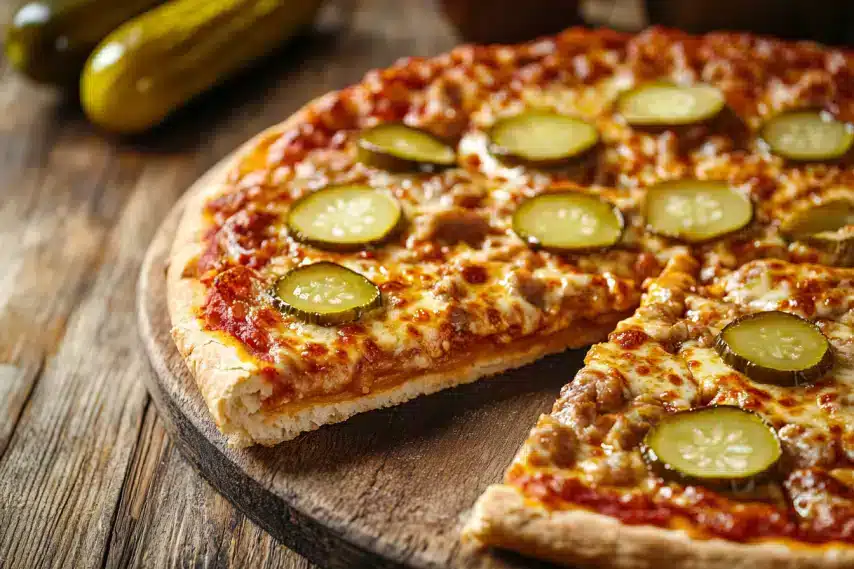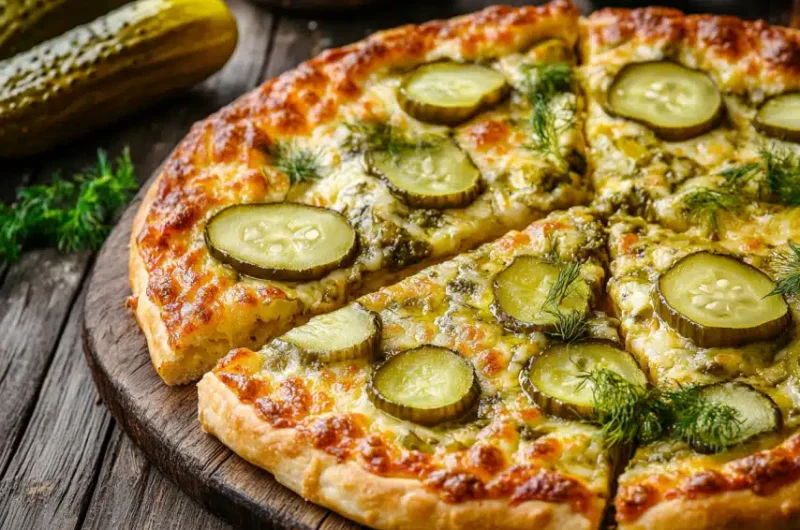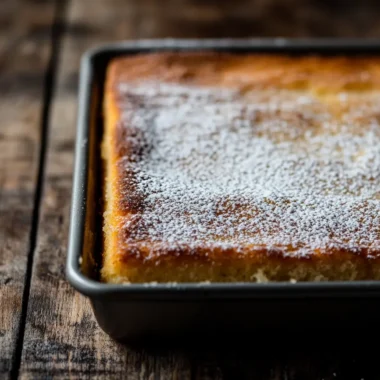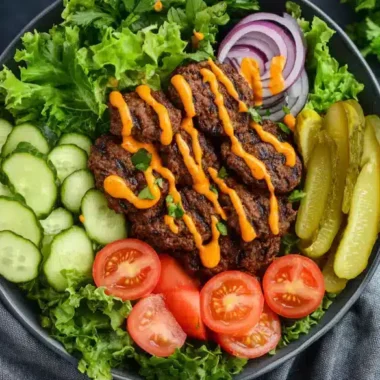Picture yourself biting into a warm, crispy crust piled high with an unexpected combination of creamy cheese, vibrant sauces, and those unmistakably snappy pickle slices. Pickle pie pizza is more than just a novel dish—it’s a gastronomic mashup that has intrigued culinary explorers, ignited social media chatter, and revolutionized ordinary pizza nights. In fact, what began as an oddball experiment now commands a serious following, as kitchens everywhere embrace this tangy-sour sensation. While some remain skeptical, others crave these out-of-the-box flavors, finding something delightfully comforting in each slice. In the following sections, we’ll dive into the background of this rising trend, discover its global influences, learn how to craft it step-by-step, and explore the best ways to make it your new signature specialty at home. Not to mention, we’ll tackle nutritional insights and answer burning questions. Are you ready to embark on a flavorful journey? Let’s begin.
The Origin and Evolution of Pickle Pie Pizza
A Brief History of Pickled Foods in Pizza Culture
Weaving pickled ingredients into baked dough has roots that stretch back through many vibrant food cultures. Though pizza with pickles might sound exotic, fermented vegetables have long adorned flatbreads in regions where tangy flavors spark mealtime excitement. Middle Eastern, Eastern European, and Mediterranean cuisines, for instance, commonly integrate brined veggies into breads and pies. Yet, truly niche “pickled pizza” concepts—especially the pickled pie pizza—emerged only recently. Initially, most pizzerias stuck to classic tomato sauce and mozzarella, but artisanal bakers experimenting with fermentation techniques began challenging these norms. As curiosity grew, so did the presence of crunchy pickles layered beneath melted cheese and savory toppings. Suddenly, diners found that pickled goodness enhanced complexity: bursts of acidity balanced rich sauces, cheese, and doughy bites. As the trend blossomed, it inspired not only adventurous taste buds, but also culinary innovators who dared to push boundaries.
From Classic Pies to Experimental Pickle Pie Pizza: Culinary Trends
Shifts in the pizza landscape often arise from restless food enthusiasts who crave unexpected flavor combinations. Think about how barbecue chicken pizza upended conventions decades ago, or how dessert pizzas sprinkled with fresh fruit rattled purist sensibilities. In that spirit, the birth of pickle pie pizza represents another leap forward. Initially spotted in niche culinary circles, it quickly captured attention on social media, where people showcased their homemade experiments or praised local spots serving the unusual treat. Because it tastes both familiar and daring—melding comfort (pizza) with quirkiness (pickles)—this particular mashup carved a niche faster than most culinary novelties. Its runaway popularity stems from the interplay of tangy brine against creamy cheese, as well as its inherent photogenic appeal. Before anyone knew it, this once-wacky pie became a mainstay on menus and an irresistible dare among food adventurers.
Influences from Regional and International Flavors
The evolution of pickle pie pizza didn’t unfold in isolation. Each region contributed its own spin, leveraging indigenous pickling traditions. Eastern Europe’s beloved dill pickles inspired briny toppings, while Asian pickled vegetables introduced heat and complexity. Meanwhile, North American chefs toyed with sweet pickles, mustard-based sauces, and even unconventional crusts. By blending global culinary elements, this dish transcended boundaries, captivating palates from coast to coast. Indeed, as cultural exchange accelerates, every new adaptation is a nod to centuries-old pickling practices elsewhere, resulting in a truly global fusion.
Cultural Acceptance and Popularity in Restaurants
As more eateries embraced this zingy fusion, the dish shifted from quirky fad to genuine crowd-pleaser. Initially, only a handful of specialty restaurants dared serve it, but patrons kept coming back, often surprising themselves with how addictive the taste was. Soon, savvy restaurateurs recognized that featuring pickle pie pizza tapped into a growing desire for unique experiences. Today, it’s not uncommon to spot it on menus at avant-garde pizzerias, trendy eateries, and gourmet food trucks. This cultural acceptance reflects broader shifts in how we eat—welcoming unexpected pairings and savoring each culinary twist.
Essential Ingredients and Unique Flavor Combinations

Choosing the Right Dough and Crust Options
At the heart of any great pizza lies the dough. For pickle pie pizza, a high-quality, artisanal crust proves crucial. After all, tangy toppings demand a sturdy yet springy base to absorb flavors without collapsing. Classic Neapolitan dough can work wonders, but experimenting with sourdough introduces subtle fermented notes that amplify the overall complexity. Whole wheat or spelt flours lend nuttiness, while gluten-free blends cater to those with dietary restrictions. Don’t hesitate to try unique pizza dough techniques that ensure the crust’s texture remains airy and crisp at the edges. Ultimately, the dough should harmonize with tangy pickles and rich cheeses, never overpowering them.
Selecting the Perfect Pickles: Dill, Sweet, or Spicy?
While dill remains the superstar of pickled toppings, you needn’t limit yourself. Consider layering sweet pickles for a gentle contrast or even adding spicy pickled jalapeños for a fiery kick. The type of pickle you choose can completely transform the dish’s personality. Dill pickles deliver a classic zing, meshing beautifully with creamy sauces and fresh herbs. Sweet pickles pair unexpectedly well with salty cheeses, creating a more mellow, comforting bite. Meanwhile, spicy options galvanize the palate, ensuring each mouthful lingers delightfully. Mix and match various styles to find your signature blend—after all, this is a pickle-forward recipe made for personalization.
Cheese Varieties that Complement the Tang
Cheese is your ally, smoothing the pickle’s sharp edges and enhancing its tart notes. Traditional mozzarella offers a neutral canvas, allowing the pickle’s flavors to shine. For added depth, sprinkle in tangy feta, sharp cheddar, or creamy goat cheese. If you’re feeling adventurous, try raclette or Gruyère for a nutty sweetness that harmonizes with the sour crunch beneath. Think about texture: a gooey melt contrasts beautifully with the crisp pickle. Ultimately, a well-chosen cheese encourages a savory-sour combination that stays balanced, coaxing layers of complexity from every bite.
Sauce Innovations: Mustard, Aioli, and Beyond
While tomato sauce remains a fixture on most pizzas, pickle pie pizza encourages broader experimentation. Mustard-based sauces introduce brightness and subtle spice that complements brined cucumbers. A creamy aioli, enlivened with garlic or herbs, can highlight delicate cheese flavors. For a bolder approach, consider a tangy white sauce infused with pickle juice. As you break free from tradition, trust your taste buds—any sauce that enhances briny character and keeps the overall flavor balanced is worth exploring.
Balancing Additional Toppings: Vegetables, Herbs, and Proteins
Finally, round out your creation with fresh produce and herbs—think crunchy bell peppers, fresh basil, or even a sprinkle of arugula. Light proteins like roasted chicken or plant-based alternatives offer subtle savoriness without dominating. The goal: achieve a harmonious tapestry where each element supports the pickle’s tangy glory.
Health Benefits and Nutritional Profile

Vitamins and Minerals in Pickles and Fermented Foods
Beyond their unmistakable zing, pickles bring noteworthy nutrients. Fermented vegetables often contain probiotics beneficial for gut health, potentially aiding digestion and supporting immune function. Pickles provide small amounts of vitamins like K and C, as well as minerals such as potassium. Though not a nutritional powerhouse, these brined cucumbers offer more than just flavor. Incorporating them into a pizza might give you a modest boost of beneficial bacteria, making each slice a pleasant, health-oriented treat. Just remember that moderation is key, since some pickles carry a higher sodium content.
Comparing Pickle Pie Pizza to Traditional Options
Compared to traditional pepperoni or heavy-cheese pies, pickle pie pizza can feel lighter and more refreshing. Pickles help cut through richness, so you may be satisfied with fewer slices. Also, relying on vegetable toppings and fermented foods could enhance overall nutrient density. While this dish doesn’t suddenly transform pizza into a “health food,” the presence of bright, tangy elements and potentially lighter sauces does encourage mindful eating habits. By focusing on quality ingredients, you’ll discover that indulging in savory fun can still fit into a balanced lifestyle.
Crafting a Balanced Meal: Pairings and Sides
While pickle pie pizza stands strong on its own, thoughtful pairings elevate the experience. Consider serving it alongside a crisp salad sprinkled with fresh dill or a side of light vegetable soup. Non-alcoholic, palate-cleansing beverages like sparkling water infused with citrus can reset your taste buds, ensuring you savor each slice anew. By embracing these complementary flavors, you’ll enjoy a well-rounded meal that satisfies cravings without tipping into excess. With every tangy bite, you’ll appreciate how pickles, cheese, and dough coalesce into a unique culinary adventure that respects both flavor and well-being.Part 2
How to Make Pickle Pie Pizza at Home
Essential Kitchen Tools and Equipment
When you’re ready to whip up a pickle pie pizza in your own kitchen, the right tools smooth the entire process. Therefore, gather a sturdy rolling pin, a large mixing bowl, a reliable baking sheet or pizza stone, and a sharp chef’s knife. Moreover, having a stand mixer for kneading dough can save time, yet it’s not mandatory. In fact, a trusty wooden spoon, silicone spatula, and parchment paper will often do the trick. Additionally, a pizza peel makes transferring the raw, topped dough into the oven easier. Ultimately, well-chosen tools streamline preparation, ensuring a stress-free, homemade pickle pizza experience.
Step-by-Step Dough Preparation
Crafting the foundation of any pizza with pickles requires attention to detail. Start by mixing warm water and yeast, then let it proof until foamy. Meanwhile, measure your flour and salt accurately. Once the yeast mixture is ready, pour it into the dry ingredients and stir until a shaggy dough forms. Next, add a splash of olive oil and gently knead, either by hand or with a stand mixer’s dough hook. Furthermore, incorporate artisanal flour blends or experiment with unique pizza dough techniques to introduce nuance. After about 10 minutes of kneading, your dough should feel smooth, springy, and not overly sticky.
Transfer the dough into a lightly oiled bowl, cover it with a damp cloth, and let it rise in a warm spot. While the dough doubles in size—usually an hour or two—spend that downtime daydreaming about your chosen toppings. Finally, punch down the dough, shape it into a round ball, and let it rest again briefly. Now you’ve got the perfect base to roll out and host that tangy, briny magic.
Crafting the Perfect Sauce Base
Although many traditional pies lean on tomato sauce, pickle pie pizza begs for something bolder. Hence, try whipping up a tangy mustard-cream sauce that teases out pickle flavors. Start with a few tablespoons of good-quality mustard—Dijon or whole grain—then combine it with sour cream, a bit of Greek yogurt, or even an herb-infused aioli. Additionally, a dash of pickle brine brightens everything, ensuring layers of savory depth. Stir until smooth, taste often, and adjust seasoning as necessary.
Alternatively, consider a thin, neutral white sauce seasoned gently with garlic and herbs. Moreover, remember that your sauce should never dominate; it should harmonize with the pickled toppings. Ultimately, balance is key, so trust your palate and don’t shy away from subtle tweaks.
Layering Your Pickle Pie Pizza with Toppings
Start with your stretched dough placed on parchment paper or a floured peel. Then, spread a thin layer of sauce, leaving a border for the crust. Next, add cheese—mozzarella is standard, but blending in tangy cheddar or creamy goat cheese can elevate complexity. Now, carefully distribute your pickle slices, whether dill, sweet, or spicy, ensuring an even coverage. Furthermore, consider thinly sliced onions, roasted vegetables, or fresh herbs to complement the brine. Sprinkle a bit more cheese on top for that irresistible melt.
In fact, this is your opportunity to experiment. Do you fancy pairing crunchy pickles with crisp peppers or thinly shaved asparagus? Go for it! Above all, remember the star ingredient: those tangy pickles should shine through, so don’t bury them beneath too many competing flavors.
Baking Techniques and Temperature Tips
Preheat your oven as high as safely possible—around 475°F to 500°F—so that the crust cooks quickly, crisps nicely, and doesn’t turn soggy. Moreover, placing a pizza stone or baking steel in the oven before preheating can produce a sublime, char-kissed bottom. After you slide the assembled pickled pizza pie into the oven, resist the urge to open the door too frequently. Check for doneness after about 8-12 minutes. Consequently, you’ll know it’s ready when the cheese bubbles, the crust darkens slightly at the edges, and the aroma of fresh bread and tangy brine wafts enticingly through your kitchen.
Common Mistakes to Avoid
Even the most careful cooks stumble. For instance, overloading your pie with too many toppings can yield a soggy middle. Additionally, using pickles that are too wet might make your crust less crisp, so always pat them dry first. Another misstep involves under-seasoning the sauce; thus, taste it and adjust salt levels before assembly. Likewise, baking at insufficient heat can produce a rubbery crust. Finally, remember not to skimp on quality ingredients. Although shortcuts may tempt you, top-notch pickles, artisanal cheeses, and fresh dough elevate your homemade pickle pizza recipe, ensuring every slice emerges as a culinary masterpiece.
Creative Variations and Inspiring Recipes
Sweet and Tangy Maple-Pickle Pizza
For an unexpected twist, drizzle a hint of pure maple syrup over your pickled toppings. While this might sound outlandish, maple’s subtle sweetness enhances the bright acidity of dill pickles. Top your dough with a creamy white sauce, mild mozzarella, and a few shreds of sharp cheddar. Next, scatter thinly sliced dill pickles and add delicate onion slivers. After baking, garnish with a whisper of maple syrup to weave together tangy, salty, and sweet notes. The result: a balanced flavor profile that leaves diners pleasantly perplexed. This innovative approach proves that pickle pie pizza lends itself to endless, creative possibilities.
Spicy Jalapeño Pickle Pie Pizza
For those craving a fiery kick, incorporate spicy pickled jalapeños into the mix. Start with a mustard-based sauce and add a dash of sriracha or chili paste. Then, top with shredded pepper Jack cheese and a handful of dill pickle rounds. Scatter thin slices of pickled jalapeños strategically to ensure each bite offers a zesty pop. Finally, dust the surface with a pinch of dried oregano for aromatic depth. This culinary mashup strikes a balance between tang and heat, encouraging adventurous eaters to embrace a bold new frontier. After all, who says you can’t turn up the volume on sour comfort foods?
Vegan Pickle Pie Pizza with Dairy-Free Cheese
While cheese typically provides creaminess, vegans need not miss out on tangy goodness. Fortunately, an array of dairy-free cheeses, such as cashew-based mozzarella or plant-based cheddar, replicate that luscious melt. Begin with a simple vegan white sauce—blend soaked cashews, lemon juice, garlic, and dill—and spread it evenly. Add layers of your preferred vegan cheese and top with crisp pickle slices. Subsequently, consider roasted mushrooms, caramelized onions, or thin zucchini ribbons. Each element complements the brine while maintaining a cruelty-free ethos. Vegan diners can celebrate this fusion cuisine knowing they haven’t sacrificed flavor, texture, or the joys of experimentation.
Gluten-Free Options and Crust Alternatives
Gluten sensitivity shouldn’t deny anyone a tangy, pickle-packed feast. By choosing gluten-free crusts—made from blends of rice, almond, or sorghum flours—your pickle pie pizza still emerges with crunchy edges and a chewy center. In addition, consider cauliflower-based crusts or chickpea flour flatbreads. Although these alternatives impart distinct flavors, they’ll support your toppings and enhance overall complexity. Remember to pre-bake gluten-free crusts slightly before adding sauce and toppings, as this step helps maintain crispness. In the end, tailoring your pizza to personal dietary needs proves easier than ever, ensuring that everyone savors the bright flavors of dill pickle slices and creamy sauces.
Fun Twists: Miniature Pizzas and Calzones
If the classic round pie doesn’t entice you, try shaping your dough into personal-sized rounds for miniature variations. These bite-sized wonders delight dinner guests and kids alike, offering manageable portions and encouraging experimentation. Alternatively, fold the dough over the fillings to create a calzone stuffed with pickles and cheese. As you break it open, tangy steam wafts forth, surprising those who expect ordinary fillings. These whimsical formats broaden the appeal of pickle pie pizza, proving it’s not just a single recipe but rather an evolving concept ready to be explored.
(Explore more creative pizza inspiration to discover inventive toppings and unique flavor pairings.)
Serving Suggestions and Presentation
Cutting Techniques and Slicing Styles
Presentation counts. Although classic wedges remain a solid choice, consider experimenting with square or rectangular slices to emphasize the uniqueness of pickled pizza pie. Cutting smaller pieces invites more sampling, which helps guests appreciate subtle differences in toppings. Furthermore, a pizza wheel or sharp chef’s knife ensures clean edges and even portions. Above all, arrange slices on a wooden board to highlight the rustic charm of tangy crust and crisp pickles. Your guests will notice and remember even these small details.
Pairing Beverages and Non-Alcoholic Drinks
Refreshments matter when you’re serving something so tangy. Instead of traditional pairings, lean toward sparkling water with a twist of lime, cucumber-infused seltzer, or even a lightly sweet iced tea. Although soda can work, consider fresh-pressed juices that complement the briny flavors. For instance, a watermelon-mint cooler or a ginger-infused lemonade adds contrasting brightness. In this way, every sip resets your palate, ensuring that each subsequent bite of pickle pie pizza remains exhilarating. After all, taste is a journey, and carefully chosen beverages guide you along that flavorful path.
Aesthetics: Garnishes, Color Contrast, and Table Setting
To impress your guests, think beyond flavor. Colorful garnishes, like finely chopped herbs, delicate edible flowers, or a sprinkle of chili flakes, add visual interest. Meanwhile, choose a complementary table setting: rustic wooden boards, neutral-toned linens, and simple ceramic plates that let the pizza’s vibrant toppings shine. Even subtle touches, such as folded napkins and a bright salad centerpiece, encourage a convivial atmosphere. Ultimately, presentation transforms a humble pickle pie pizza into a memorable gastronomic event, engaging sight and smell as much as taste. Your diners will leave not only satisfied, but also inspired to create their own culinary treasures.
Frequently Asked Questions About Pickle Pie Pizza
Is Pickle Pie Pizza Suitable for Kids?
While some children may balk at unusual toppings, pickle pie pizza actually offers a fun way to introduce new flavors. In fact, kids who enjoy tangy, crunchy snacks like pickles might be pleasantly surprised. Try starting with milder pickles or a half-and-half pizza—one side pickle-free, the other briny and adventurous—thus allowing young eaters to sample a single slice before fully committing. Moreover, encouraging them to customize with favorite cheeses or mild sauces can help ease them in. Ultimately, by presenting it as a culinary adventure, you may broaden their palates without forcing unfamiliar tastes too quickly.
Can I Use Different Types of Pickles?
Absolutely! Using a variety of pickles can add excitement and depth. Dill pickles lend classic sour notes, while bread-and-butter varieties deliver a sweeter, more subdued tang. You might also explore spicy pickled jalapeños or even pickled vegetables like carrots or radishes. By mixing and matching different pickled items, you’ll discover new combinations that highlight textures, flavors, and aromas. Ultimately, there’s no strict rule here—if it’s brined, crisp, and appeals to your taste, it can star on a pizza with pickles. This flexibility ensures that each pie you create remains personal, customizable, and endlessly intriguing.
How Long Does It Keep After Baking?
Freshly baked pickle pie pizza tastes best when served hot, but leftovers can last about two to three days in the refrigerator. Before storing, let the pizza cool completely to prevent sogginess, then wrap slices tightly or place them in an airtight container. Although the crust may lose some crispness over time, gently reheating in the oven or a toaster oven helps restore texture and melts the cheese anew. While pickles maintain their tang even after a day or two, try not to wait too long before enjoying leftovers—after all, the whole point is to savor that briny brightness.
Any Tips for Making It Healthier?
You can tweak your pickle pie pizza to boost its nutritional profile. Consider using a whole-grain or gluten-free crust for added fiber and easier digestion. Employ lighter sauces made from Greek yogurt or plant-based bases, which reduce saturated fats. Incorporate plenty of veggie toppings—colorful peppers, mushrooms, and leafy greens—to increase vitamin intake. Opt for moderate cheese portions, possibly choosing lower-fat varieties if desired. Finally, serve with a crisp side salad or a simple vegetable soup. By making mindful choices, you maintain the delightful tangy flavors yet achieve a more balanced meal that supports a health-conscious lifestyle.
Conclusion: Embrace the Tangy Revolution
In a world brimming with culinary experiments, pickle pie pizza stands out as an approachable yet offbeat masterpiece that redefines traditional pizza boundaries. Although it might sound peculiar at first, this fusion of tangy pickles, creamy cheeses, and crusty dough proves that stretching your palate’s comfort zone can yield unforgettable flavor journeys. After all, it’s not merely about slapping pickles onto a pie—it’s about achieving a delicate balance, one that celebrates fermented foods, cherished traditions, and bold innovations all at once.
Moreover, the joy lies in experimentation. You hold the reins, choosing dough variations, pickle styles, sauce bases, and finishing touches. With each tweak, you refine the dish into something uniquely yours. And, as you serve this eccentric creation to family and friends, you spark lively conversations, surprise their taste buds, and perhaps inspire a few skeptics to embrace new culinary horizons.
Ultimately, pickle pie pizza invites you to break the mold, rethink what belongs on a crust, and savor unexpected harmonies. So go ahead—roll up your sleeves, fling some dough, and let your kitchen become a tasting laboratory. Embrace the tangy revolution and cherish every deliciously daring bite.






